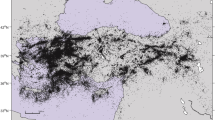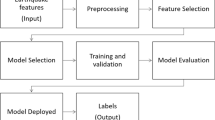Abstract
Bayesian inference shows that the distribution of the future event not only depends on the past events (prior), but also depends on the relation between the past and the future events (likelihood). However, the classical Bayesian methods do not consider the important contributions of recent data. In this paper, we propose a new Bayesian inference-based training method, which can be used as online training for Bayesian methods. We give the training methods for the exponential and the normal models. We successfully apply this method for the seismic parameter prediction using the data of central Italy from 2014 to 2017. Comparisons show our method is more effective than the other Bayesian methods.










Similar content being viewed by others
References
Cai M et al (2017) On a simple and efficient approach to probability distribution function aggregation. IEEE Trans Syst Man Cybern Syst 47(9):2444–2453
Cao ZJ, Wang Y, Li DQ (2016) Site-specific characterization of soil properties using multiple measurements from different test procedures at different locations. A Bayesian sequential updating approach. Eng Geol 211:150–161
Cornell CA (1972) Bayesian statistical decision theory and reliability-based design. In: Proceedings of the international conference on structural safety and reliability, Washington, D.C., Smithsonian Institute, pp 47–66
Cua G, Heaton T (2007) The virtual seismologist (VS) method: a Bayesian approach to earthquake early warning. In: Earthquake early warning systems. Springer, Berlin, pp 97–132
de la Rosa E, Yu W (2020) Data-driven fuzzy modeling using restricted Boltzmann machines and probability theory. IEEE Trans Syst Man Cybern Syst 50(7):2316–2326
Egozcue J, Ruttener E (1997) Bayesian techniques for seismic hazard assessment using imprecise data. Nat Hazards 14(2–3):91–112
Fan B, Lu X, Li H-X (2016) Probabilistic inference-based least squares support vector machine for modeling under noisy environment. IEEE Trans Syst Man Cybern Syst 46(12):1703–1710
Gordon J, Hernández-Lobato JM (2017) Bayesian semisupervised learning with deep generative models. arXiv preprint arXiv:1706.09751
Griffiths T, Yuille A (2008) A primer on probabilistic inference. In: The probabilistic mind: prospects for Bayesian cognitive science, pp 33–57
Gutenberg B, Richter C (1944) Frequency of earthquakes in California. Bull Seismol Soc Am 34(4):185–188
Hoff Peter DA (2009) First course in Bayesian statistical methods. Springer, Berlin
Huang J, Zeng C, Kelly R (2019) Back analysis of settlement of Teven Road trial embankment using Bayesian updating. Georisk Assess Manag Risk Eng Syst Geohazards 13(4):320–325
Kagan Y, Jackson D (1991) Long-term earthquake clustering. Geophys J Int 104(1):117–133
Li C, Liu X (2016) An improved PSO-BP neural network and its application to earthquake prediction. In: 2016 Chinese control and decision conference (CCDC). IEEE 2016
Li XY, Zhang LM, Jiang SH (2016) Updating performance of high rock slopes by combining incremental time-series monitoring data and three-dimensional numerical analysis. Int J Rock Mech Min Sci 83:252–261
Li Z et al (2021) Probabilistic back analysis for improved reliability of geotechnical predictions considering parameters uncertainty, model bias, and observation error. Tunn Undergr Space Technol 115(104051):2021
Liang F (2005) Bayesian neural networks for nonlinear time series forecasting. Stat Comput 15(1):13–29
Liang F, Liu C, Carroll R (2011) Advanced Markov chain Monte Carlo methods: learning from past samples, vol 714. Wiley, Hoboken
Liu Q, Wang J (2011) A one-layer recurrent neural network for constrained nonsmooth optimization. IEEE Trans Syst Man Cybern Syst 41(5):1323–1333
Ma H, Wang Z, Wang D, Liu D, Yan P, Wei Q (2016) Neural-network-based distributed adaptive robust control for a class of nonlinear multiagent systems with time delays and external noises. IEEE Trans Syst Man Cybern Syst 46(6):750–758
Meier MA, Heaton T, Clinton J (2015) The Gutenberg algorithm: evolutionary Bayesian magnitude estimates for earthquake early warning with a filter bank. Bull Seismol Soc Am 105(5):2774–2786
Mu C, Wang D, He H (2018) Data-driven finite-horizon approximate optimal control for discrete-time nonlinear systems using iterative HDP approach. IEEE Trans Cybern 48(10):2948–2961
Stavrakakis G, Drakopoulos J (1995) Bayesian probabilities of earthquake occurrences in Greece and surrounding areas. Pure Appl Geophys 144(2):307–319
Stavrakakis G, Tselentis GA (1987) Bayesian probabilistic prediction of strong earthquakes in the main seismogenic zones of Greece. Bolletino di Geofisica Teorica et Applicata XXIX 113:51–63
Stiphou T, Zhuang J, Marsa M (2012) Seismicity declustering. Community Online Resour Stat Seism Anal. https://doi.org/10.5078/corssa-52382934
Telesca L, Lapenna V (2006) Measuring multifractality in seismic sequences. Tectonophysics 423(1–4):115–123
Telesca L, Lovallo M, Lopez C, Molist J (2016) Multiparametric statistical investigation of seismicity occurred at El Hierro (Canary Islands) from 2011 to 2014. Tectonophysics 672:121–128
Telesca L, Fat-Elbary R, Stabile T (2017) Dynamical characterization of the 1982–2015 seismicity of Aswan region (Egypt). Tectonophysics 712:132–144
Vasyuraâ Bathke H, Dettmer J, Steinberg A, Heimann S, Isken MP, Zielke O, Jónsson S (2020) The Bayesian earthquake analysis tool. Seismol Res Lett 91(2A):1003–1018
Walsh D, Arnold R, Townend J (2009) A Bayesian approach to determining and parametrizing earthquake focal mechanisms. Geophys J Int 176(1):235–255
Wang JP, Brant L (2015) Two Bayesian algorithms for the estimation of earthquake parameters. Earthq Spectra 31(1):565–578
Wang J, Chang S, Wu Y, Xu Y (2015) Bayesian analysis on earthquake magnitude related to an active fault in Taiwan. Soil Dyn Earthq Eng 75:18–26
Yang W, Xu Y, Wang JP (2017) Characterising soil property in an area with limited measurement: a Bayesian approach. Georisk Assess Manag Risk Eng Syst Geohazards 11(2):189–196
Yin L, Andrews J, Heaton T (2018) Rapid earthquake discrimination for earthquake early warning: a Bayesian probabilistic approach using three-component single-station waveforms and seismicity forecast. Bull Seismol Soc Am 108(4):2054–2067
Zhang H, Cui L, Zhang X, Luo Y (2011) Data-driven robust approximate optimal tracking control for unknown general nonlinear systems using adaptive dynamic programming method. IEEE Trans Neural Netw 22(12):2226–2236
Funding
This work was supported in part by CONACYT under grant CONACyT-A1-S-8216 and in part by CINVESTAV under grant SEP-CINVESTAV #62 and Grant CNR-CINVESTAV.
Author information
Authors and Affiliations
Corresponding author
Ethics declarations
Conflict of interest
The authors declare that they have conflict of interest in this paper.
Ethical approval
This article does not contain any studies with human participants or animals performed by any of the authors.
Additional information
Publisher's Note
Springer Nature remains neutral with regard to jurisdictional claims in published maps and institutional affiliations.
Rights and permissions
About this article
Cite this article
Morales, J., Yu, W. & Telesca, L. Bayesian inference for data-driven training with application to seismic parameter prediction. Soft Comput 26, 867–876 (2022). https://doi.org/10.1007/s00500-021-06232-z
Accepted:
Published:
Issue Date:
DOI: https://doi.org/10.1007/s00500-021-06232-z




